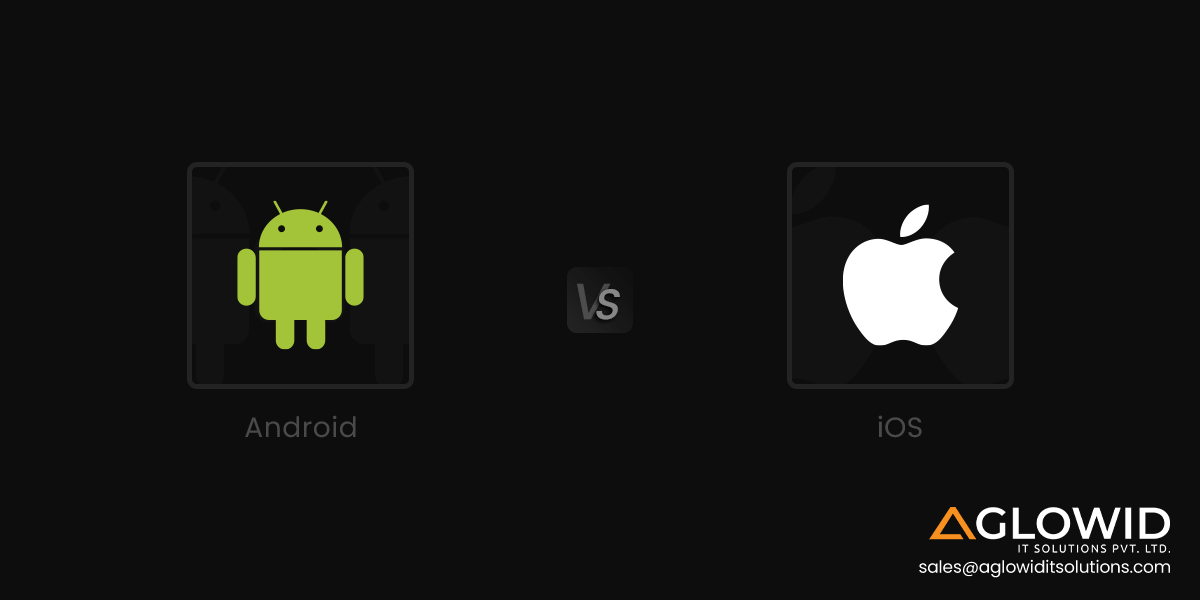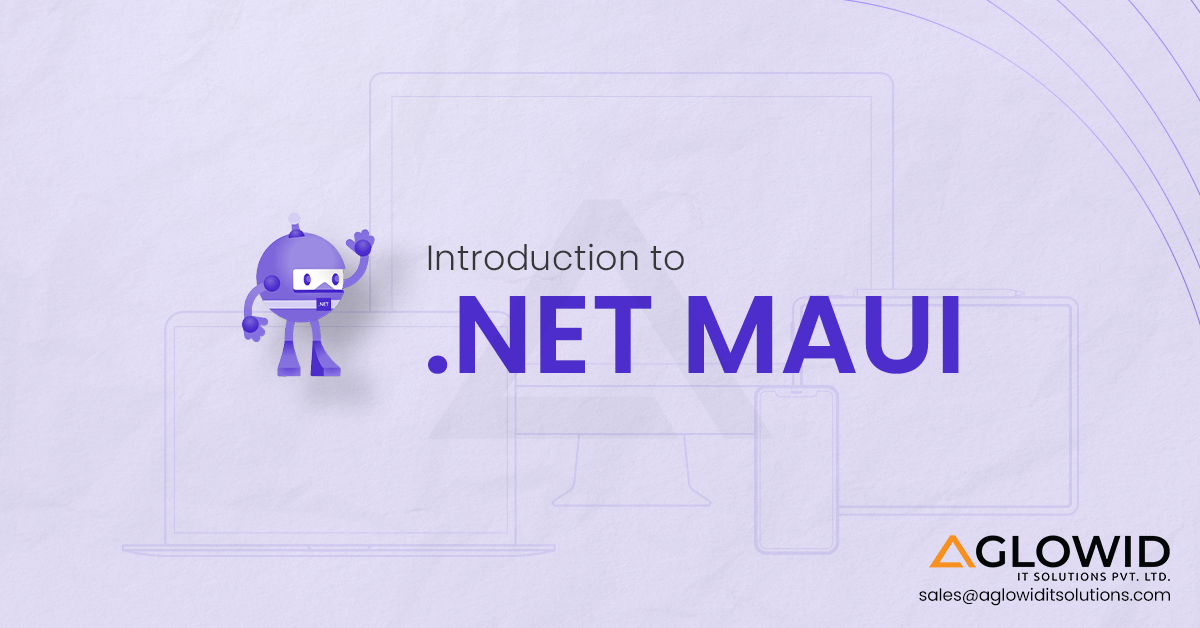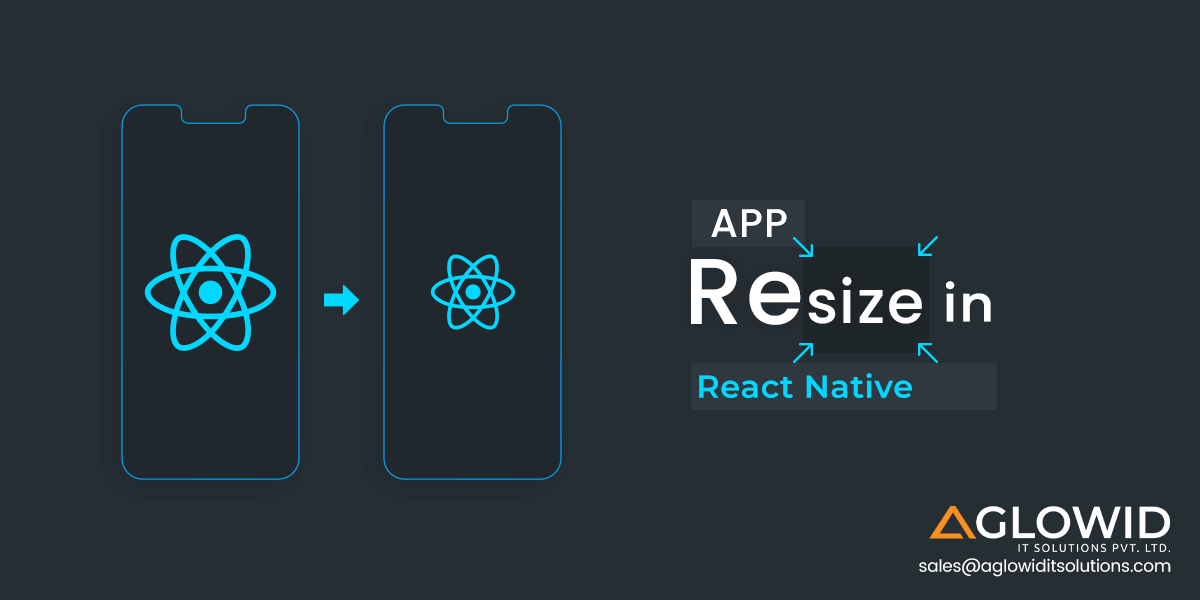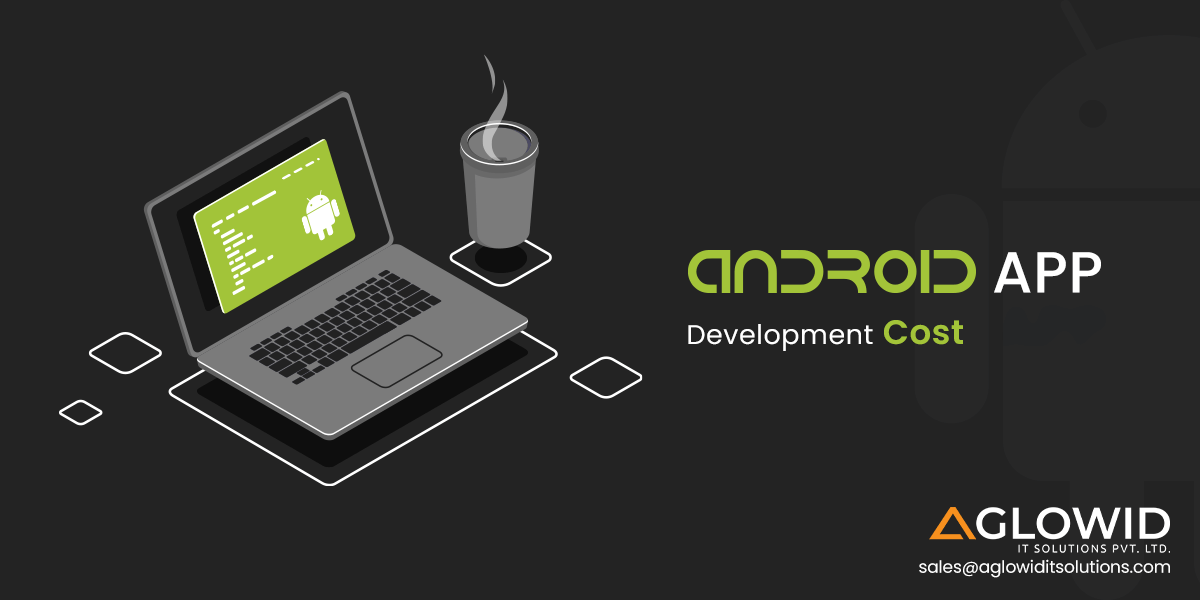iOS vs Android is the ultimate clash between two tech giants ruling the mobile software development front. Mobile app development is one of the fastest-growing markets in the arena of software production. With the ever-growing number of people accessing the internet using their smartphones and tablets, mobile app development opens up greater opportunities for businesses to reach a large pool of potential customers.
As per Statista, global mobile app revenues currently stand at an outstanding figure of 693 billion US dollars, which is projected to rise to 935.2 billion US dollars by 2023.
This only shows the endless possibilities and potential of diving into mobile app development.
Android 12 vs iOS 15
The latest versions of Android and iOS are Android 12 and iOS 15, respectively. Android 12 will be the 19th version of Android, and the first beta was released on May 18, 2021. In contrast, Apple released its iOS 15 on September 16, 2020. Many new features, changes, and important updates would revolutionize both the software’s capabilities. Let’s have a look at what we can expect –
Android 12 – Noteworthy Features
1. Material You
Material You is Google’s radical new approach to design. It follows a hyper-personalized approach to design custom appearances for various interfaces and apps that adapts to the users’ behavior.

Key Features of Material You –
- Material palettes – pick colors from wallpaper and apply them to the entire mobile experience.
- Maintains a fine balance between design sensibility and personal preferences.
- Adaptive to new screen sizes, input modalities, device types and context by utilizing motion.
2. All New Privacy Dashboard
Google is pushing privacy and ease of privacy by making it easier for users to track apps that accessed permissions, including camera, microphone, location and more.
Privacy Dashboard Features –
- The New ‘Privacy Dashboard’ feature shows all apps with all the access they have to user’s data.
- Timestamps that indicate when each app used each permission.
- Mic and Camera indicators in the status bar. Users can deactivate both by going to Quick Settings.
- ‘Toast Notification’ will appear below the screen every time user copies data from the app to the clipboard.
3. Nearby Share for Wi-Fi Passwords
Earlier, Android users could share their Wi-Fi connections with people near them using the barcode scanner. Now, with Android 12, users will also get an option that says ‘Nearby.’ Once you enable nearby sharing, your device will look for devices near you to share the details with.
iOS 15 – Noteworthy Features
1. A completely new Home Screen with App Library
Yes, you read it right! iOS is finally changing the iOS home screen and introducing much awaited App Library where all your iOS apps will be present. This also means that you will now be able to eliminate apps from your home screen and eliminate additional home screens. While iOS is extremely late to this party when compared to Android, it is a welcomed change.
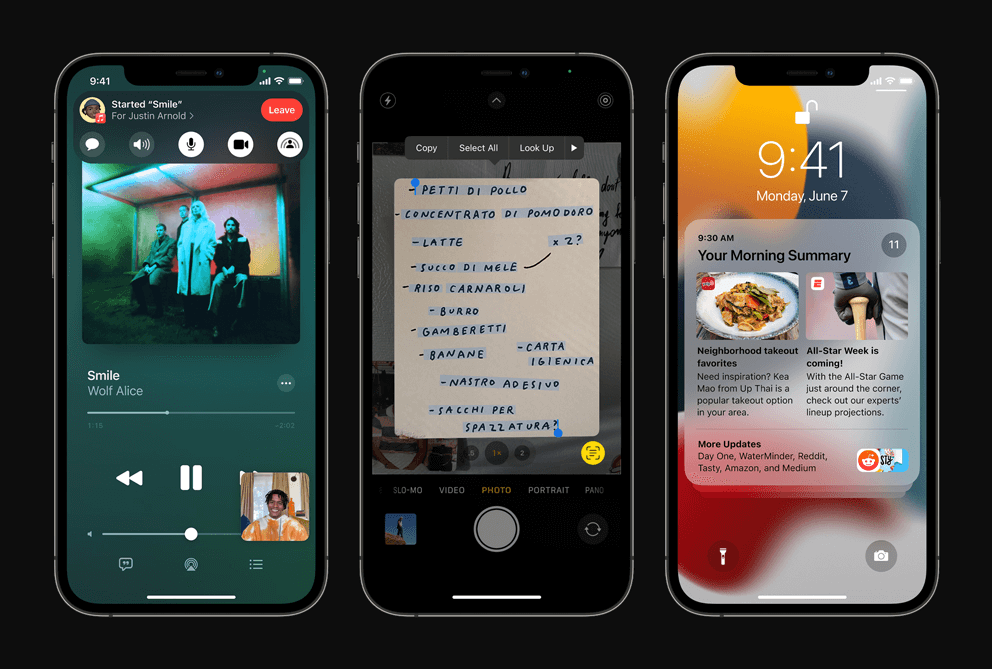
Key Features of the New Home Screen with App Library
- Automatic grouping of all apps together into big folders that show the most recently used apps.
- Search bar option for quickly searching your app from your list of apps.
- Automatic folder categorization like Social, Health and Fitness, Gaming etc.
2. The all-new App Clips
Apple is constantly innovating new and practical solutions for its users to access content with ease. For example, this year, they released their new App Clips that are micro parts of apps that enable users to use specific apps without downloading, installing, sign-in, or doing any such activity for performing one simple task.
Key Features of the App Clips
- Developers can build App clips for their apps.
- Instant payment at coffee shops and other places without needing to download a full-sized app.
3. Revamping Apple Maps
Google Maps has been the undisputed winner for both iOS and Android users when it comes to maps. Apple decided to turn things around this year by redesigning its Map services with some promising visualizations and features.
Key Features of the Apple Maps
- Detailed representation of elevation changes, bike lanes, stairs.
- Location of speed cameras, red-light cameras, congestion zones.
- See specialized electric vehicle routing by adding your electric vehicle to your iPhone.
Why iOS is better than Android?
Most developers and users prefer iOS compared to Android as their daily driver and preferred mobile app development software. Here are certain points that favor iOS over Android –
- Apple’s closed ecosystem allows Apple to make both – OS and Hardware, which no other company can use to integrate with their services. Hence, Apple always has better sync between software and hardware.
- Easy to use – iOS was developed with ease of use in mind. Since iOS barely pushes customization options, it adds simplicity to the UI, making users habitual to its design.
- Regular and consistent updates -Apple has a better update timeline, and the update rolls out for every device on the same day.
- iOS vs Android security – iOS leaves Android way behind when it comes to security. No one can get into an iPhone without the users’ permission. In addition, iOS has memory encryption which enables data confidentiality.
Why Android is better than iOS?
Android currently owns 72.72 percent market share in the mobile operating system sector globally. Many Android Geeks prefer Android over iOS. Here are some key features where Android is better than iOS –
- Ultimate customization options – Android is known for providing its users with various customization options to fine-tune the software as per their needs or preferences.
- Seamless Google integration – Android integrates seamlessly with Google’s services – Docs, Gmail, and Drive, Maps, Music, Chrome and more.
- Wider inclusivity – The majority of smartphone brands use Android for powering their OS; hence there is a wider pool of companies to choose from and various phones that belong to different price segments as well.
Compare and Contrast iOS and Android Tablet –
Before we proceed further and start comparing important aspects of mobile app development between iOS and Android platforms, let us first go through some basic features to get a quick overview of the overall iOS and Android structure.
| Key Features | iOS | Android |
| Core | UNIX | LINUX |
| Development Language | Swift | Java, Kotlin |
| Target Audience | Focused, purchase-driven | Wider, numbers-driven |
| Integrated Development Environment | Xcode | Android Studio |
| Development Nature | Closed | Open |
| Complexity | Intermediate | Difficult |
| Apple Store & Play Store Acceptance/Deployment Speed | Longer | Quicker |
| Apple Store & Play Store App Publishing Fee | $99/year | $25 (one-time) |
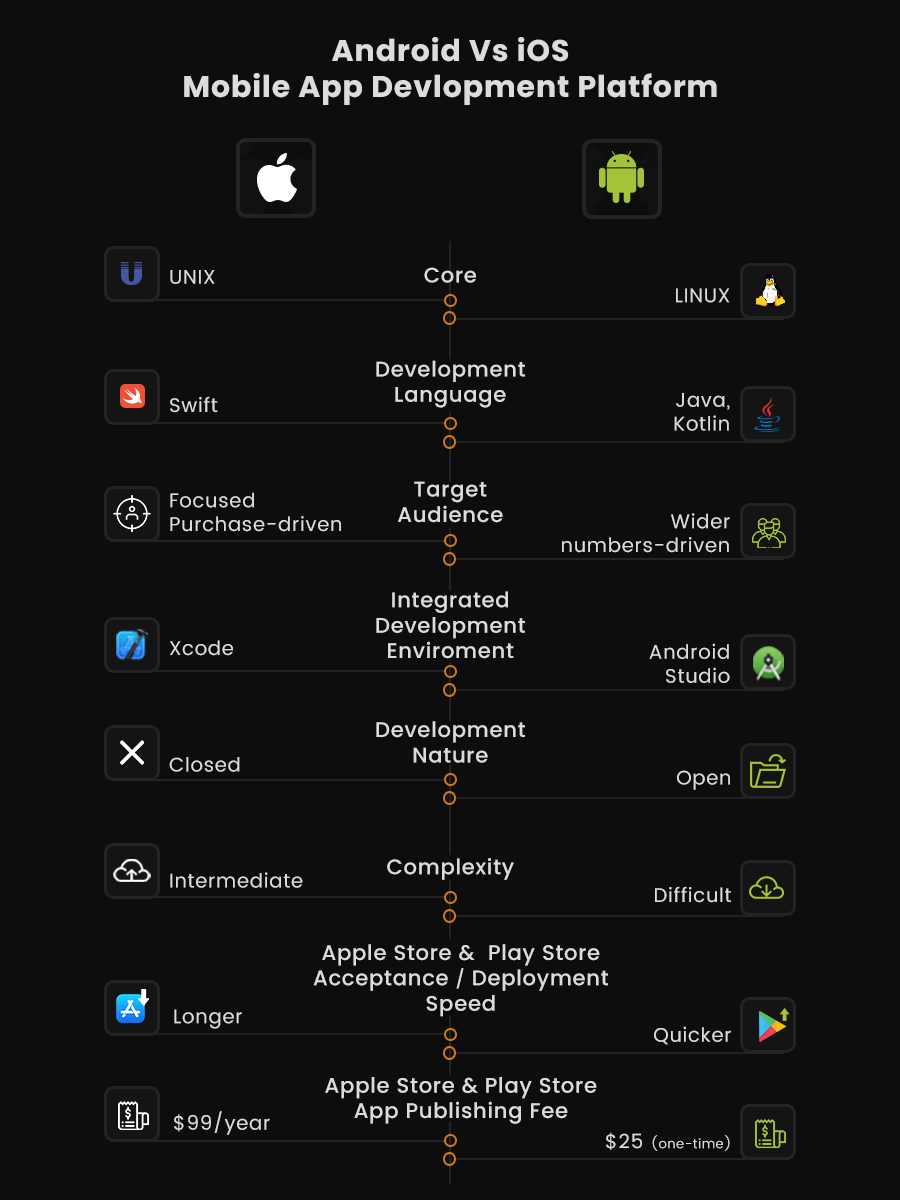
Battle of the mobile software – iOS vs Android 2024
Now that we have understood the general perception around iOS and Android, we can dive deeper into answering the evergreen question – Which is better, iPhone or Android? There are various factors that one needs to consider for a fair comparison between iOS and Android. The features we would test both these platforms against each other are –
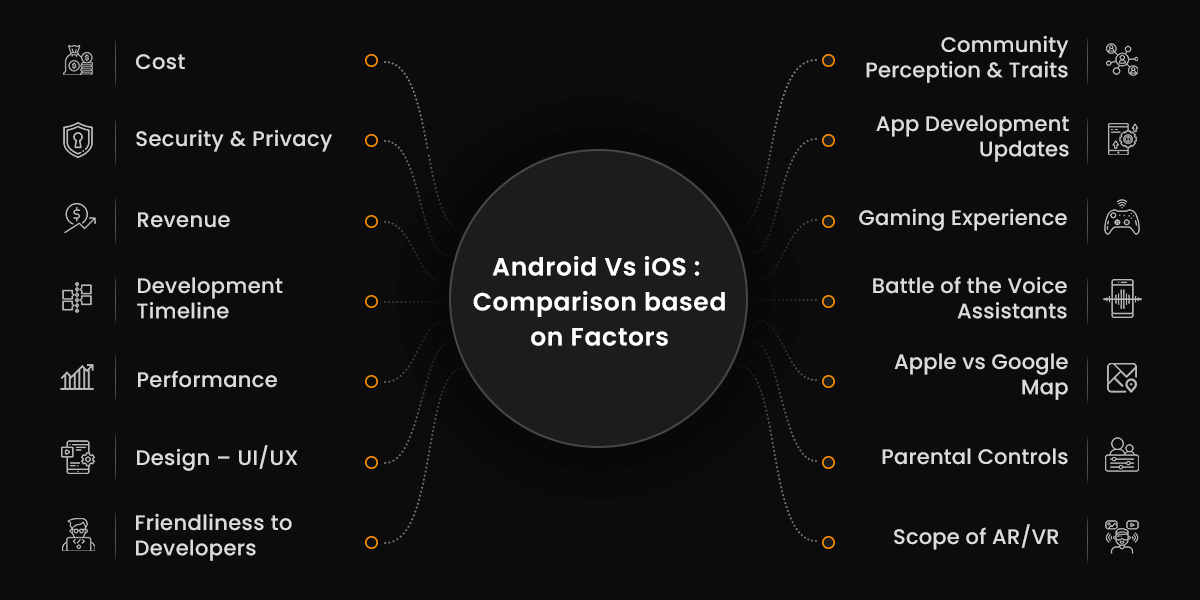
1. iOS vs Android 2024 – Cost Comparison
In the battle of iOS vs Android development, you should first and foremost consider the mobile app development costs and various other related costs of both platforms. Here we have systematically broken down different cost aspects you should consider for deciding whether iOS or Android is better.
a. iOS vs Android Level of complexity
Your app development costs directly are affected by the level of app complexity you want to build. Generally, app complexities are divided into three segments –
| App Type | Description | Android | iOS | ||
| Time/months | Cost | Time/months | Cost | ||
| Basic |
|
3 | $10,000 | 3 | $10,000 |
| Medium |
|
8 | $60,000 | 8 | $65,000 |
| Enterprise |
|
15 | $100,000 | 15 | $120,000 |
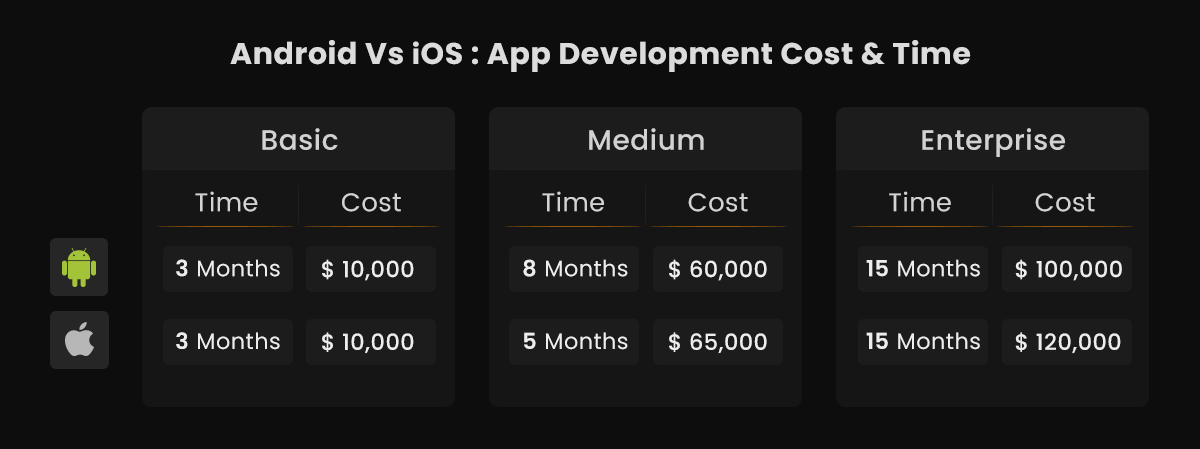
b. iOS vs Android Hourly Rates
The demand for Dedicated iOS developers is higher than that for Dedicated Android developers; hence, the average hourly rates are usually higher for iOS developers compared to Android developers.
Looking for Android App Developers to develop cutting edge native app?
Hire Professional Android App Developers from Aglowid to develop highly scalable and performance-oriented mobile app project.
As per payscale.com, the average salary for an iOS developer is –

Whereas the average salary for Android Developer is –

c. iOS vs. Android Design Cost
Both Android and iOS follow different design philosophies. However, both platforms have guidelines that help developers create appealing and user-friendly user interfaces. For example, Google calls its design guidelines – Material Design, whereas Apple calls its design guidelines Human Interface Guidelines.
The average cost for iOS app design is $500-$1000. This price depends on the apps’ size, complexity, and the average designer’s hourly rates. If you want your app to run and look good on other Apple devices like the iPad, you might look at additional charges for the same. Whereas for Android, the average Android app design cost ranges from $650-$1200.
d. iOS vs Android Development Cost
Android runs on Java, a bulkier language with more lines of codes than Swift for iOS. Another aspect to consider is, there is better documentation available for Java with stronger community response to troubleshoot any Java problems you might encounter. Android lags in the fragmentation sector. Since Android is open-source and used by many smartphone brands, adjusting to all screen sizes and OS variants significantly delay the overall Android development time. iOS plays in a smaller pool of Apple devices; hence, it doesn’t suffer from this issue. The average cost of iOS app development stands at $7500, whereas for Android app development cost, can be around $9300.
e. iOS vs Android Country-wise development cost comparison
Mobile development rates are also majorly affected by region of development. Based on the average pay scale of Android and iOS developers, each country charges different rates for its app development services.
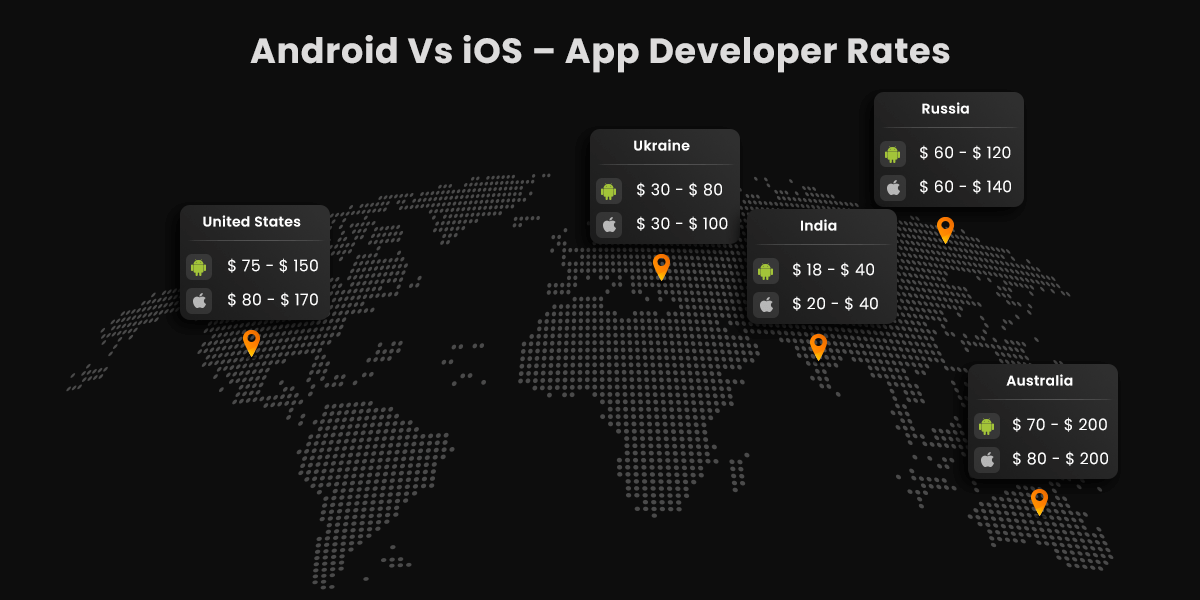
| Platform | India | United States | Ukraine | Australia | Russia |
| Android Development Cost | $18-$40/hr | $75-$150/hr | $30-$80/hr | $70-$200/hr | $60-$120/hr |
| iOS app development cost | $20-40/hr | $80-$170/hr | $30-$100/hr | $80-$200/hr | $60-$140/hr |
While you can see, the cheapest mobile app development services are available in India, you should also notice that overall Android app development costs are higher than iOS app development costs across the globe.
2. iOS vs. Android 2024 Security and Privacy
Many factors affect and impact the security and privacy aspects of mobile app development on both these platforms. Privacy and security are two of the most important aspects of mobile app development. Depending on the kind of app you develop, the level of security integration can vary accordingly. A financial/banking app would need higher security protocols compared to a gaming app. Let us understand how both these companies approach privacy and security in their way –
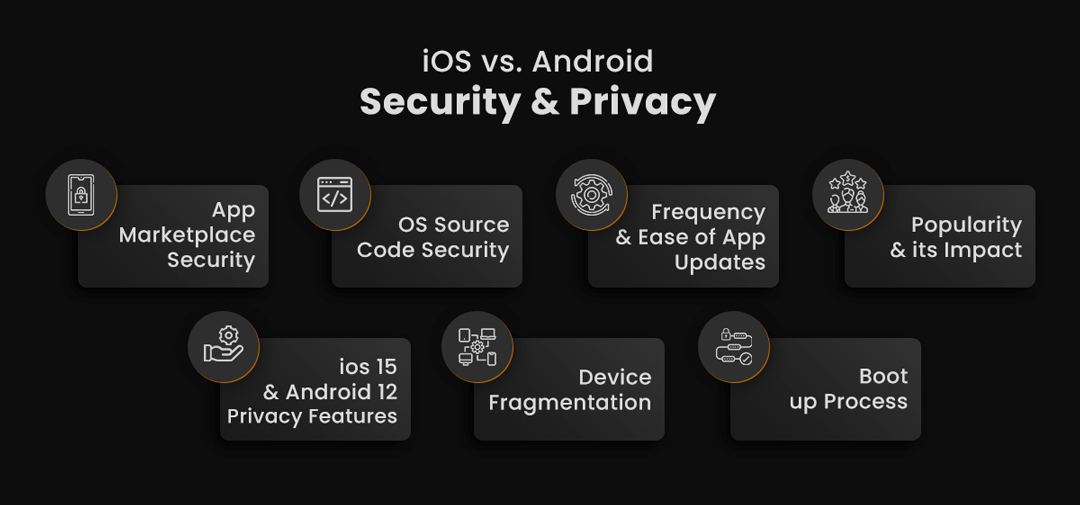
a. App Marketplace Security
Android and iOS have different approaches and attitudes towards their app marketplaces and the way they monitor them. For example, Android’s play store is an open marketplace with a significantly larger number of apps than the iOS app store.
As per Statista, Google Play Store users can choose from $3.48 million apps, whereas Apple’s App Store provides $2.2 million apps for iOS.
However, due to the open nature of the Google Play Store, there is always a higher chance of hackers enter the platform and distribute malware apps. The android marketplace has witnessed several occasions where top trending apps with numerous downloads have been found to have malware in them. Android also allows users to allow apps from outside the Android app store. This increases the risk of malware.
As opposed to this, Apple is known for keeping tight borders and being strict with its app approval system. It inspects every app on the Apple app store, which results in fewer apps, but this practice helps them remove or reduce the chances of allowing malware in their app stores.
b. OS Source Code Security
Again, following the same core philosophy, Android keeps its OS open-source, whereas Apple secures its source code in a closed environment. Since Apple keeps a closed source code, hackers have a hard time finding security loopholes. Android is open-source, which could easily be translated to it being prone to hackers. However, it also means Android is more accessible to a variety of developers. Google is leveraging this concept by offering appealing bounties to independent security researchers for reporting any new vulnerabilities. Hence, there can be no declared winner for OS Source Code security.
c. Frequency and Ease of Providing App Updates
For any mobile app development software, providing constant app updates for easing control over the device, fixing bugs, and providing consistent security. By providing constant updates, iOS and Android can provide consistent security to their users. In addition, apple follows a closed ecosystem, which makes updates easier to create and distribute. This also helps Apple keep provide iOS updates for longer durations, generally lasting up to 5 years.
Google-based Android empowers 1000s of smartphone brands globally. With that kind of distribution, Google can’t maintain the same security updates across all devices for the same duration and frequency. This also causes trouble with update rolling, as they need to interact with different manufacturers and devices individually. Hence, Android updates come out at longer intervals and a lesser frequency.
d. Popularity and its Impact
As we discussed previously, Android has a significantly more number of apps on the play store and every 8 out of 10 devices are powered by Android. Clearly, Android is more popular than Apple. However, this very popularity works against them when it comes to security measures, as hackers take a greater interest in penetrating such a rich market instead of small, closed and private Apple ecosystem. Now there are many native and third-party security apps to tackle these challenges for Android users; however, an informed understanding is a must to optimally utilize them.
e. iOS vs Android – iOS 15 & Android 12 Privacy Features
We briefly discussed the various new features that Android 12 and iOS15 are bringing to the table. Another important aspect of these new updates are the security features they came up with. Android 12 has taken security very seriously, and it might finally be catching up with iOS on this aspect. Let us take a better look –
| Wins for Android12 | Wins for iOS15 |
| Google’s New Privacy Dashboard.
|
Tracking permissions for Apple users. Now you can manually disallow Apple app developers to track your use of certain apps and websites to send you targeted ads.
|
| Users can see which apps accessed their location, camera, mic, other permissions, and use duration.
|
More control over local network access. If you do not think an app needs access to communicate with your Bluetooth or Wi-Fi devices, you can simply click ‘Don’t Allow’ now to ensure they can’t access your local network devices. In addition, you can enable or disable it for any specific apps.
|
| Introduction of an indicator on the status bar for users to know when an Android app uses their app or mic.
|
Microphone and camera detection sensor on the top of the screen. Similar to Android.
|
| Introduction of Approximate Location Sharing allows users to send an estimated location when they do not want the receiver to know their exact location.
|
Sharing Approximate Location – same as Android.
|
| Introduction of Private Compute Core – audio and language processing will happen on devices isolated from any networks, helping you preserve your privacy.
|
Giving limited access to photos. Of course, many photo-editing apps would ask for gallery access and justifiably so. However, if you have sensitive pictures that you do not want to give access to more, with iOS 15, you will be able to give these apps limited access to selected images.
|
f. Device Fragmentation
As we talked about device fragmentation in the cost section, Android powers any smartphone brand and device, making it difficult to provide a consistent security and privacy standard across all smartphone brands. Moreover, besides working with these smartphones, they also sometimes like to add their custom skin to Android OS, which can again complicate the security protocols. In this aspect, Apple’s closed environment proves beneficial.
g. Boot up Process
Android as a platform is based on Linux Kernel and Inter-Process communication facility and security level. It gives a verified boot guarantee by using Application Sandbox that verifies each stage cryptographically to test the integrity of the next stage before verifying them. Android uses the dm-verity kernel feature to verify the boots, making it impossible for any compromised device to boot.
As opposed to this, iOS uses a low-level bootloader, iOS kernel and iBootLLB. It uses the Boot ROM program to utilize Apple Root CS Public Key for ensuring iBoot Bootloader only executes if Apple signs it.
Planning to Hire iOS Developers to build reliable interactive iOS app project?
Hire iOS application developers form Aglowid for high-performing, performance-driven, industry-grade iOS applications.
3. iOS vs. Android for Business
When it comes to launching an app for your business, there are many considerations before finalizing your strategy. Your first consideration will be –
- Who are your target audience?
- What platform do you want to target? iOS, Android, or both?
- What are your app requirements?
- What type of app development agency you need? Offshore, In-house, Freelancers?
To understand these aspects better, you can refer to our blog – How to Find App Developers for your Startup?
4. iOS vs Android 2024 App Revenue Comparison
Let us get directly to it. Android has more number of apps, but iOS has better app revenues. Why? Well, there a couple of factors that we should discuss –
iOS vs Android – Revenue Factors
Demographics
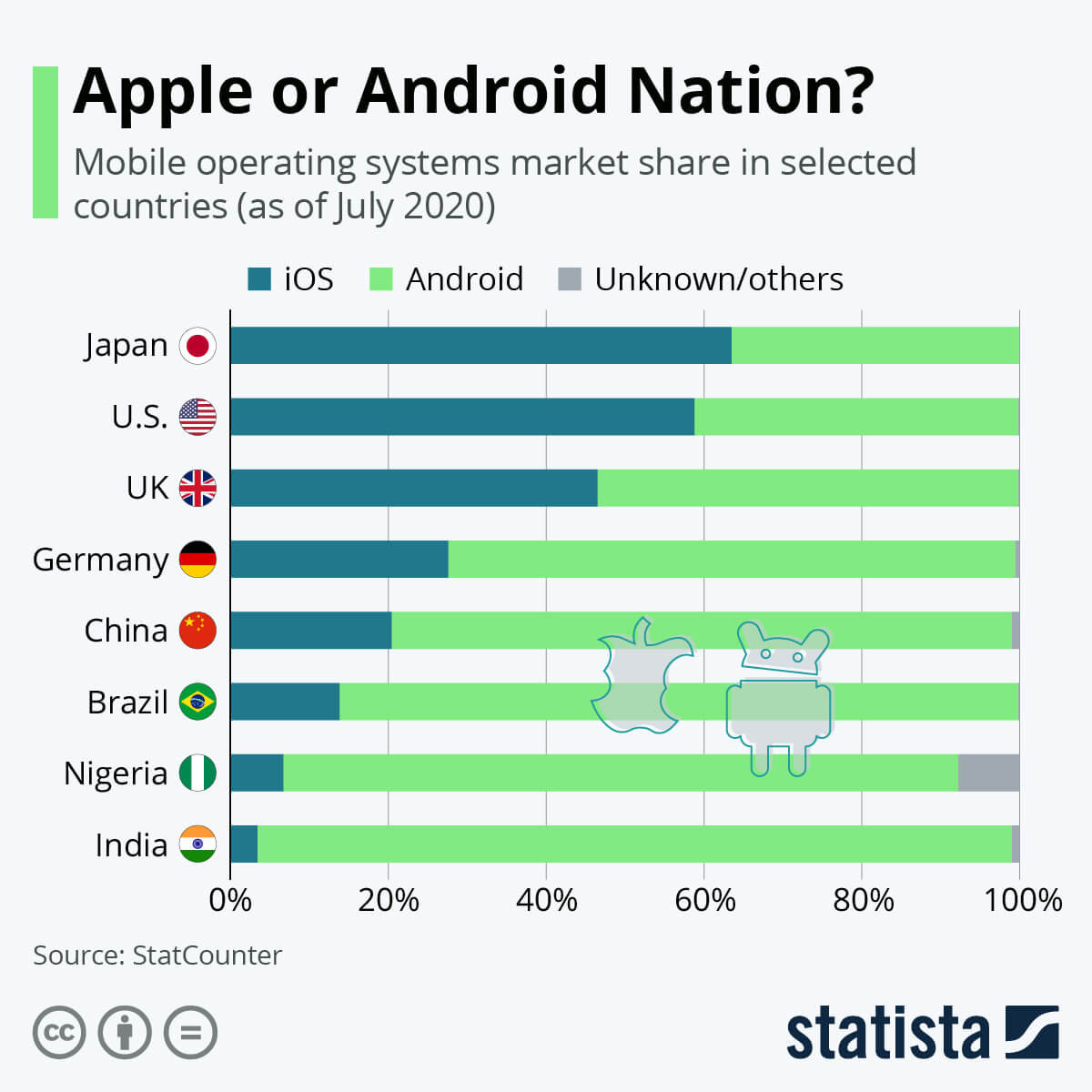
As you can see in this Statista Chart, the global smartphone market, Android OS dominates the overall market in terms of the percentage of devices that run either of the software. As per Statista, Android had an 87 percent market share of the smartphone industry in 2019, whereas Apple had only 13 percent of the overall market share.
However, on a closer inspection, you can observe that Apple reigns control over Android is top developed countries such as Japan, the US and UK compared to Android, which is more popular in developing countries like India, Brazil and Nigeria. So naturally, developed countries have higher salaries and more disposable income to spend on mobile apps than developing countries, which brings us to our next point.
In-App Purchases
In-app purchases are a crucial revenue stream method for any mobile app company to make money off. Most Google Play Store apps work on a free/freemium model. Free apps generally make money from in-app advertisements, whereas freemium apps have in-app offerings to enhance the user capabilities or experience of utilizing that app.
Here are some stats as per Android Authority that showcase the distinction between IAP behaviors of Android and iOS users –
- iOS users are 50 percent more likely to spend on in-app purchases.
- 1 percent of iOS developers make one payment per month as opposed to 4.6% Android users.
- iOS users spend nearly 2.5 times more on in-app purchases than Android users.
iOS vs Android -App Revenue Stats
Now that we have understood the basic factors affecting the differences in Android and iOS app revenues, we should dive into numbers! So here are some interesting facts about iOS vs Android app revenue differences.
Overall App Revenues
Annual App Revenue
| Year | App Revenue |
| 2016 | $43.5 billion |
| 2017 | $58.1 billion |
| 2018 | $71.3 billion |
| 2019 | $89 billion |
| 2020 | $111 billion |
Annual app revenue shows steady and substantial growth from 2016 to 2020, with a higher rate of growth in the years of 2019 and 2020 due to the global pandemic and lockdowns.
iOS App Revenues vs Android App Revenues
iOS app revenues
| Year | iOS app revenue |
| 2016 | $28.6 billion |
| 2017 | $38.5 billion |
| 2018 | $46.6 billion |
| 2019 | $58.4 billion |
| 2020 | $72.3 billion |
Android App Revenues
| Year | Android App Revenue |
| 2016 | $15 billion |
| 2017 | $21.2 billion |
| 2018 | $24.8 billion |
| 2019 | $30.6 billion |
| 2020 | $38.6 billion |
Apple’s app store is significantly behind Android in total users, but as you can see in terms of revenue, Apple has always stayed significantly ahead of Android. If we talk about the percentage increase in overall Android revenue, it has seen a 167 percent rise in the last four years. Hence, even though Apple is currently leading in-app revenue, Android is picking up speed to reduce the gap.
5. iOS vs. Android 2024 – Battle of Voice Assistants
‘Ok Google’ and ‘Hey Siri’ are two of the most spoken keywords around the globe these days for operating various smart gadgets like mobile phones, tablets, laptops, smart TVs, and home appliances. Voice assistants have changed the way users communicate and interact with their smart devices. With voice assistants, you can ask questions or give commands. Android’s voice assistant is Google Assistant, whereas Apple’s voice assistant is Siri.
The battle of Google Assistant vs Siri is as intense as iOS vs. Android. Here, we have broken down the capabilities of these two promising voice assistants as per different factors that you should consider to truly select one of them as a winner.
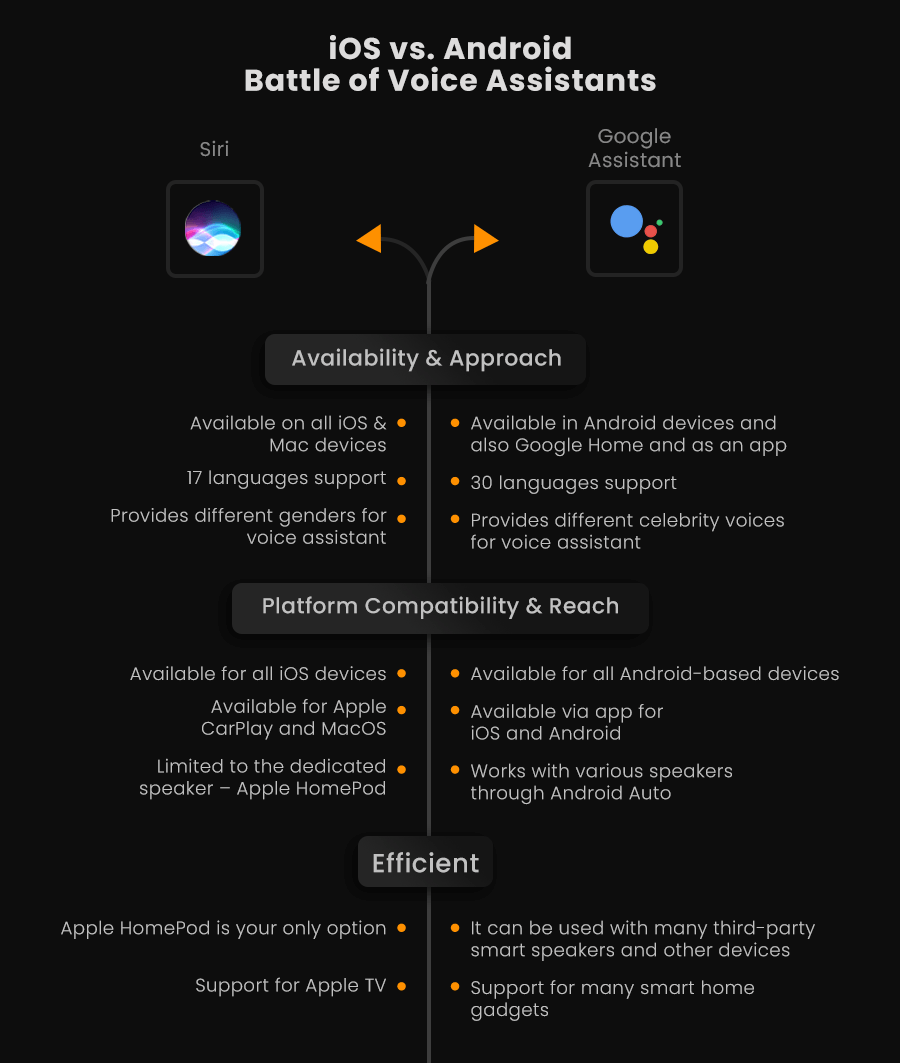
Availability and Approach
| Siri | Google Assistant |
| Available on all iOS AND Mac devices. | Available in Android devices and also Google Home and as an app. |
| 17 languages support | 30 languages support |
| Provides different genders for voice assistant | Provides different celebrity voices for voice assistant |
Both the voice assistants – Google Assistant and Siri are similar in terms of approach and availability. They are at par with each other on the basic aspects. It all depends on what you as a user are looking for with your voice assistant.
Platform Compatibility and Reach
| Siri | Google Assistant |
| Available for all iOS devices. | Available for all Android-based devices. |
| Support for Apple CarPlay and MacOS. | Availability via app for iOS and Android. |
| Limited to the dedicated speaker – Apple HomePod. | Works with various speakers through Android Auto. |
Android’s Google Assistant is the clear winner when it comes to compatibility. You can use it on any Android-powered smart device, but moreover, it can also be used on any of your iOS devices via the Google Assistant app. Siri is enclosed in its Apple ecosystem. Many speakers were developed by many companies leveraging Google Assistant’s capabilities to make their speakers smart speakers. This opens up endless possibilities for Android users and developers.
Efficient Home Integration
| Siri | Google Assistant |
| Apple HomePod is your only option. | It can be used with many third-party smart speakers and other devices. |
| Support for Apple TV. | Support for many smart home gadgets. |
The main purpose of a voice assistant is to make your life touch-free and voice-enabled. Google Assistant provides wider accessibility between many third-party alternatives as opposed to the limited approach by Siri.
6. iOS vs. Android 2024 – Performance
When we think about mobile performances, we often tend to get lost in numbers and specs and take those as yardsticks to measure smart devices’ performance capabilities. The same is the case with mobile software. Android’s processors like Qualcomm and Snapdragon usually have flashy and impressive specs, yet somehow Apple’s processors often outdo Android’s processors. What makes this possible? Software to processor optimization!
Apple’s iOS is optimized to work seamlessly with the limited Apple devices available. Android does not have the privilege to be optimized or used with thousands of smart devices across brands and products. This is exactly why Apple does not need to rely on super specs to match up with high-end Android phones. Apple has better control over its production from start to end and hence can manage resources better.
7. iOS vs. Android 2024 – Design
As we discussed in the cost segment, iOS and Android have very different approaches to the overall design. For example, Android followed Material Design until 2021 but has shifted to Material You with Android 12, whereas Apple bases its design principles on Human Interface Guidelines.
Material You Design Principles
- Comfortable
- Iconoclastic
- Spirited
Human Interface Guidelines Design Principles
- Clarity
- Deference
- Depth
- Consistency
8. iOS vs Android 2024 Developer’s Choice
When talking about iOS vs. Android comparison, we must also focus on the people who use these technologies the most. iOS and Android both have many provisions and guidelines to help and attract developers to make their applications on their software. So let us understand the developer’s point of view.
Why developers prefer Android over iOS?
If you ask an Android developer why they prefer Android over iOS, these are the few advantages Android has over iOS that they will talk about –
Effortless Portability
Android is based on Java, a robust, powerful, and time-tested software with portability capabilities with various platforms like Blackberry, Ubuntu, Symbian, and more. Now with Windows 10 and 11, you can easily port your Android game to the Windows ecosystem as well.
Quick and easy installation
Android allows its users to download Android apps from Play Store and external libraries as well. Hence, your app can be hosted on a third-party website and Google Play Store too. This is possible with Android SDK or by installing the app directly on the computer using the command line. Hence, your Android app is more easily available to a wider number of users which can be a good reason to invest in the Android app development platform.
Great ROI
Android development doesn’t have very specific hardware requirements, unlike iOS that needs expensive resources like Xcode or iMac to develop the app. Hence, Android is a cost-effective platform for developers as well as companies.
Freedom to be innovative and creative
Android follows Google’s philosophy of openness and creativity because of the open-source nature of Android. This allows Android developers to be creative and leverage the vast resources from Android that enhance their app’s functionality and quality.
Why developers prefer iOS over Android?
One of the biggest reasons iOS developers give to justify iOS over Android is that iOS users are more likely to spend on an app than Android users. iOS helps developers get access to a significant number of users on a limited number of devices. Here are some advantages iOS offers developers over Android –
iOS offers better earning potential
Since iOS users have a higher purchase intent, if your main strategy to earn is through app revenues, choosing iOS as your development platform will be highly beneficial.
The first-to-market advantage
Most apps are released first on iOS and then on Android, and some apps are only released on iOS and never on Android. Again, this is because there is a higher direct earning potential with iOS.
It is simply easier
You don’t need to focus on optimizing your app for a gazillion gadgets with iOS development instead of Android. Instead, you only need to test them for Apple devices like iPhones, iPads, iPods and more. This makes iOS designers’ work a lot easier than Android designers.
9. iOS vs. Android – Battle of the Maps (Apple Map vs. Google Map)
In the recently conducted WWDC2021, Apple announced a revamped Apple Map to compete with Google Maps’ monopolistic leader. The new Apple Map includes improvisations such as –
- Three-dimensional city-driving experience
- Clear distinctions between medians, bike lanes and pedestrian crosswalks
- Transit riders can now find nearby stations with more ease
- Disembark alerts for users in transit to remind them to get off at their stop
- Detailed walking directions by utilizing AR
- Indoor Maps for Airports and Malls
- Improved Siri Natural Language Guidance
While Apple has considerably improved their Maps, especially with the look and feel of the application, it is still too soon to say it can hold a candle to Google Maps as there are also some limitations that Apple Maps still needs to improve upon.
Limitations of Apple Maps
- Certain features are limited to London, Los Angeles, New York, Philadelphia, San Francisco Bay Area, Washington DC and San Diego.
- No support for offline maps
- Lack of support for multi-stop routes
- No ability to choose a stop along your route
10. Community Perception and Traits
Android users and Apple users have different characteristics and behavior when interacting with their smartphones and apps. Understanding their behavior will help us understand why Apple can generate better revenues than Android, even with a small share of the overall marketplace.
Apple Users vs Android Users – Consumer Behaviour and Characteristics
| Apple Users | Android Users |
| Higher spending power. | Lesser spending power. |
| More extroverted. | More introverted. |
| Prioritize brand loyalty. | Prioritize saving money. |
| A lesser percentage of push-notification interactions, but a higher percentage of converts. | A higher percentage of push notifications but the lesser percentage of converts. |
| More spending on m-commerce, shopping apps. | More spending on digital utility apps like anti-virus, launchers and performance boosters. |
11. iOS vs. Android – Gaming Experience
One of the major key areas in choosing a smartphone for most youngsters these days is the gaming experience the smartphone and OS provide. There are many factors to consider when it comes to gaming before deciding which of the two is better suited for your gaming requirements.
Some games come sooner on iOS.
In the gaming industry, especially if you’re a streamer, it is important to get your hands on a new game before anyone else to get that first-to-market advantage that attracts many views and monetization potential. Many developers release their game first for the iPhone and iPad before launching it on the Play Store. Making games for iOS is easier as there are only two models – iPhone and iPad.
For Android, a developer needs to test more than 18,000 smartphone companies for all their smartphone variations. Unfortunately, this also translates to increased costs for app development on Android.
The Gaming Experience
Apple made a big move back in 2016 where it uninstalled all obsolete software that didn’t match any of its requirements. This proves that Apple believes in quality over quantity. This ensures that all gaming apps on Apple are good-quality games. Google has a different approach to gaming apps. They welcome almost all kinds of gaming apps, some of which cannot be played properly too.
Restriction Free Android
Apple keeps updating its rules and policies for Apple apps to follow. Most of the time, they are so strict with these guidelines that a popular Apple app might be removed from the Apple store the next day for lack of compliance. Google barely interferes with Google gaming apps as compared to Apple. However, Google will take action against an app if there is a public uproar about its content or dissatisfaction amongst users.
12. iOS vs Android – System Updates
System updates are crucial for any mobile software platform as new updates bring bug fixes, improvements and additional features that keeps the audience hooked to your platform. Both iOS & Android give utmost priority to system updates. Let us see how the two companies compete in the battle of system updates.
Google releases new software updates annually with new features, bug fixes and improvements. They follow a unique naming system for their Android versions by naming them with starting letter of any dessert name following the English alphabetical order. In contrast, Apple follows number system for their iOS versions. iOS releases a new version annually as well. One stark contrast in iOS vs Android when it comes to system updates is the extension of OS updates that each device gets with both these software. If you own an iPhone, your device will get the latest iOS updates for several years. Android lags behind in this aspect, as it has to optimize its updates to a wider range of devices with custom skins on Android OS, which generally limits per device system updates to 2 or 3 years most.
13. iOS vs Android – ARKit vs ARCore
AR/VR is the hottest trend in technology today. It is no longer a mere gimmick and has proven itself a viable technology with the potential to revolutionize our day-to-day operations as well as some of the most challenging industrial needs. For example, Google recently came up with Depth API, whereas Apple came up with their audio patent that shows how seriously both these giants take AR/VR integration.
ARCore and ARKit are development kits for Android and iOS apps, respectively. Google was first to try AR with Tango, an AR platform that stayed operational from summer 2014 to spring 2018 without getting much hype or attention. After wrapping Tango up, Google came up with ARCore. ARKit came into existence in June 2017. Let us compare and contrast both these tools for their potentials –
Main Functionalities of ARCore vs ARKit
| Functionalities | ARCore | ARKit |
| Tracking | ARCore motion tracking is based on the Inertial Measurement Unit sensor. This SDK helps determine the orientation and position of the device from points in the surrounding space. | You can follow the position of the smartphone in the real world in real-time. For this, the SDK combines the VIO- Visual Inertial Odometry with data from the camera and motion sensor. |
| Brightness Estimation | Brightness is measured by using the smartphone’s light sensor. | Holds information about the estimated lighting of the real scene. |
| Understanding the Environment | ARCore can detect horizontal surfaces in real-time when you move your device. | ARKit enables iPhones and iPads to identify flat surfaces in the real world in real-time, which helps in creating a realistic integration of various virtual elements. |
ARCore vs ARKit – Similarities
- Compatibility with Java, Unity, OpenGL and Unreal.
- Both SDK offer – motion tracking, environmental awareness and brightness estimation.
- Both suffer from inaccurate space perception for homogenous walls and areas, reflecting surfaces and areas with low light.
- Same basic operating principle.
ARCore vs ARKit – Sparse Maps
For mapping, ARCore gets a distinctive advantage as it can manage larger maps. Both ARCore and ARKit make use of sparse maps. However, ARKit apps only store the most recently captured location data and discard the older data. This limits the stability with which any scene can be re-localized if a user directs the camera away from it.
ARCore also tracks more feature points than ARKit. This means mapped areas can expand rapidly in ARCore powered apps. ARKit is reported to be more accurate in differentiating between vertical and horizontal surfaces.
14. iOS vs. Android 2024 – Parental Controls
With the passing years, the age at which a child gets their first smartphone is reducing significantly. These days, most ten years olds get their smartphones across the globe. However, parents are often worried about what type of phone to get for their child at such a tender age. They want a smartphone that understands and provides safety controls for parents to control how their children use and operate their devices. Moreover, they also want to put restrictions in place to ensure their child cannot access content that shouldn’t be accessed at their age. Let’s see how iOS and Android tackle this important aspect.
Compare and Contrast – Parental Controls iOS vs. Android
| Feature | iOS | Android |
| Restrict App Store | Yes | Yes |
| Prevent interaction with specific players in the Game Center | Yes | No |
| Restrict App Access | Yes | Yes |
| Block Third-Party Apps | No | Yes |
| Set Age Restrictions | Yes | No |
| View Phone Activity | No | Yes |
| Block inappropriate content | Yes | No |
Why Android is better than iOS for Parental Controls?
Though Android doesn’t have many in-built parental control features, it comes with a lot of freedom for its developers due to its open-source nature. This gives third-party parental control apps on Android more access and capabilities to limit, monitor and understand a child’s user behavior more than Apple’s restrictive parental control features can. Some alerts you can get access to with a third-party parental control app on Android are –
- Priority Alerts – Scan all SMS and web browsing activities. If anything related to drugs, suicide, bullying or other such categories shows up, you will get immediate notification on your parent app.
- App Control – Ability to block access to any apps permanently or for daily limits and schedules. You can add an approval requirement for your child to be able to interact with that app.
- Inappropriate Picture Detection – Any pictures sent to and from a child’s phone via MMS and saved on the phone can be scanned by AI-powered sensors that send an alert for a picture being potentially inappropriate.
- Contact Blocking – Block or allow SMS from any specific numbers.
Why iOS is better than Android for Parental Controls?
Though Apple is looked down on for its restrictive guidelines and accessibility for developers to build efficient parental control apps, they do have some noteworthy in-built parental controls that Android lacks.
- Website Filtering – Apple comes with predefined website filtering options like ‘All Websites,’ ‘Limit Adult Websites,’ and ‘Specific Websites Only.
- Location Tracking – Apple has an in-built location tracking feature through the kids can turn it off if they know how to.
- Family Sharing – Apple users can set up an iTunes account from a parent’s iPhone, and the parent can invite their kids to join the same account and use the same credit card to make purchases. Here apple offers an ‘Ask to Buy’ feature where the kid can click this button, and a notification will be sent to be the parent account to allow or deny the purchase.
have a unique app Idea?
Hire Certified Developers To Build Robust Feature, Rich App And Websites.
Wrapping it up!
We have reached the end of our iOS vs. Android comparison blog. Both these platforms have promising features, provisions and areas for improvement. We will keep updating this space with the latest and newest changes in both these platforms for your reference.
Also Check:
